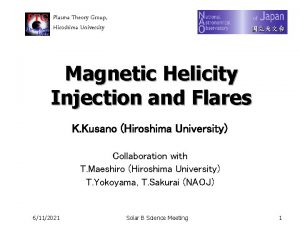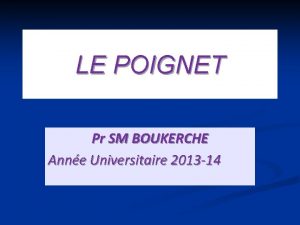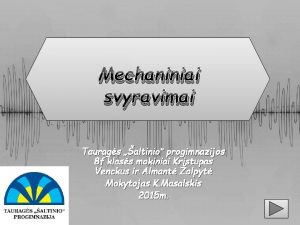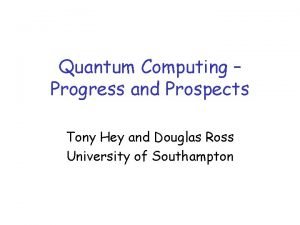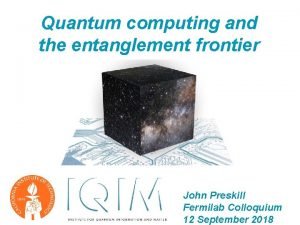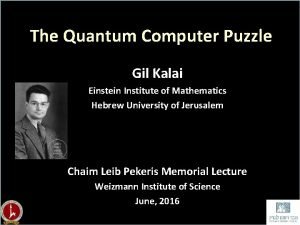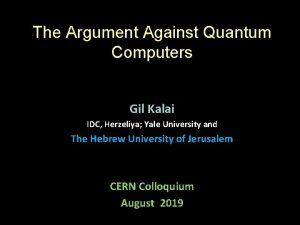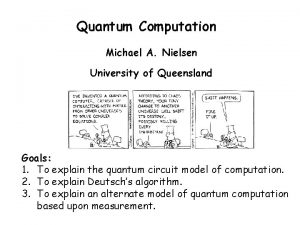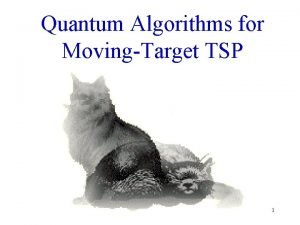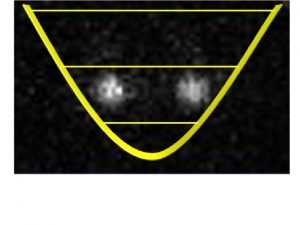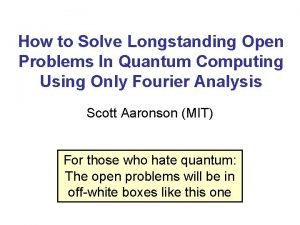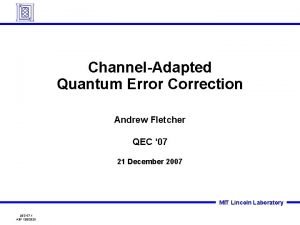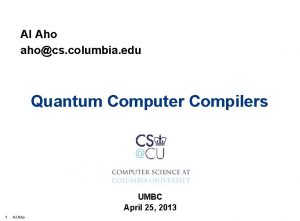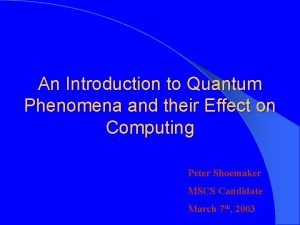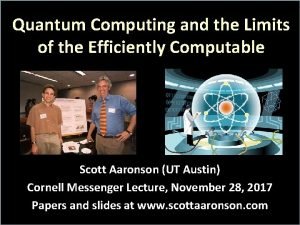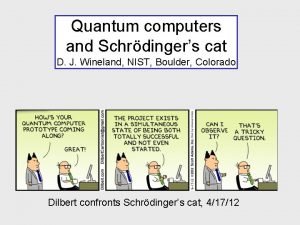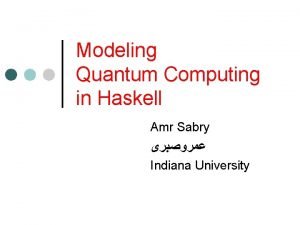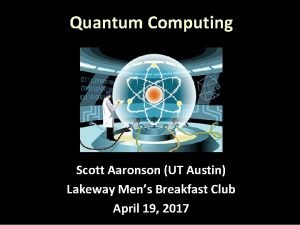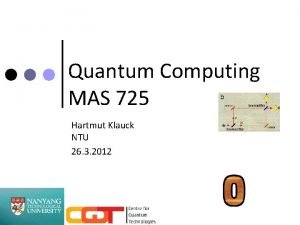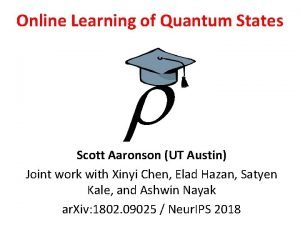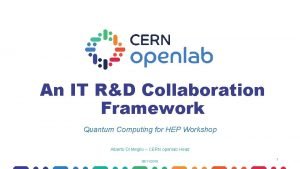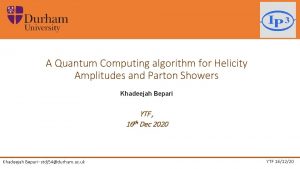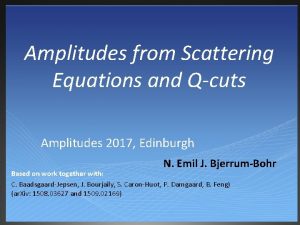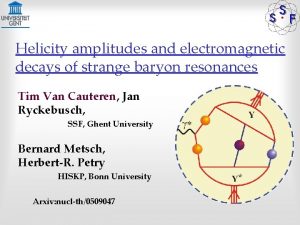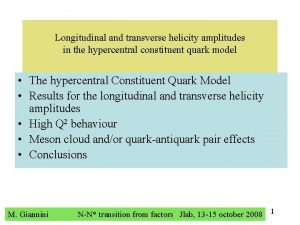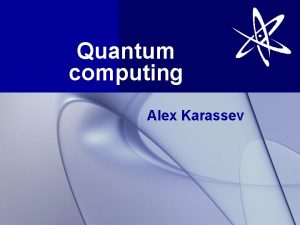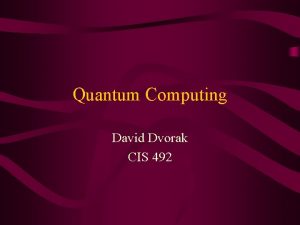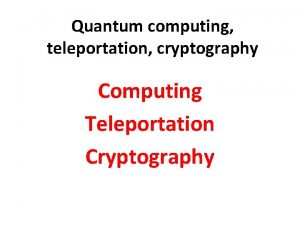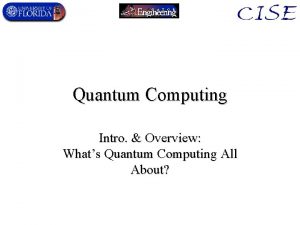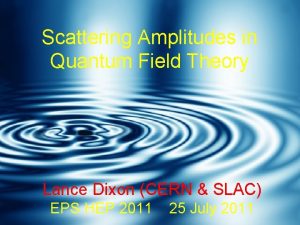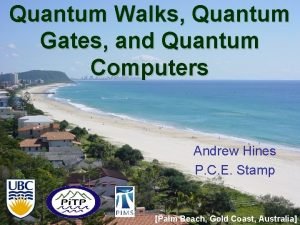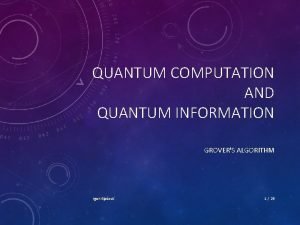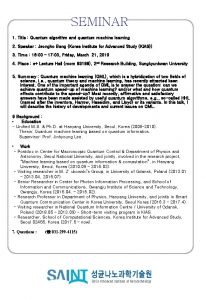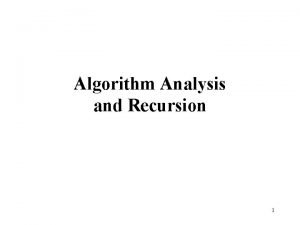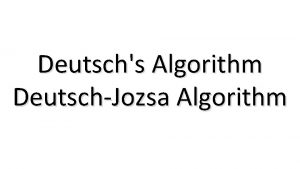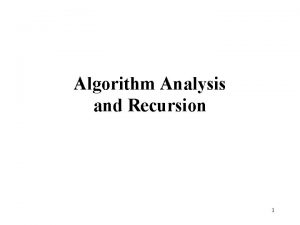A Quantum Computing algorithm for Helicity Amplitudes and























- Slides: 23

A Quantum Computing algorithm for Helicity Amplitudes and Parton Showers Khadeejah Bepari YTF , 16 th Dec 2020 Khadeejah Bepari- stdj 54@durham. ac. uk YTF 16/12/20

Introduction to Quantum Computing BLOCH SPHERE Khadeejah Bepari- stdj 54@durham. ac. uk YTF 16/12/20

Introduction to Quantum Computing Quantum Gate Computing • • • Initialise wavefunction Act with gates on states unitary operations in Hilbert space - reversible Measure wavefunction Pauli matrices (I, X, Y, Z) are examples of 1 qubit gates A subset of 1 gate and 2 qubit gates form the basis for approximating any unitary acting on 1 or 2 qubits to a high precision Quantum Anealing • • • Based on an adiabatic algorithm rather than discrete unitary transformations Keep the state of a QC close to the instantaneous ground state of Hamiltonian that varies continuously in time Time –dependent Hamiltonian that interpolates between an initial hamiltonian whose ground state can be easily prepared to a final hamiltonian whose ground state encodes the solution to the problem https: //en. wikipedia. org/wiki/Quantum_logic_gate https: //en. wikipedia. org/wiki/Quantum_annealing Khadeejah Bepari- stdj 54@durham. ac. uk YTF 16/12/20

Motivations- Why QC? • QC: Use Quantum mechanics for computation instead of Classical Physics. • Why? • Nature of Quantum Mechanics => exponential speedup over classical algorithms? • Some problems are not possible to simulate classically, or too inefficient to simulate => SHOR’S FACTORING ALGORITHM: quantum algorithm to determine prime factors of an arbitrary integer which is believed not be efficiently solvable on a classical computer • Feynman, 1982 - difficulties in simulating some of essential QM on a classical computer, a natural way to perform quantum calculations is by using quantum mechanical systems • Status: • 1970 s onwards: control single quantum systems, current quantum computer of size ~ several qubits[IBMcurrent largest GQC 65 qbts-promising 1000 qbt qc by 2023 https: //www. sciencemag. org/news/2020/09/ibm-promises-1000 -qubit-quantum-computer-milestone 2023 ], modest progress, =>efforts towards large-scale quantum information processing Khadeejah Bepari- stdj 54@durham. ac. uk YTF 16/12/20

Quantum Gates Gate Khadeejah Bepari- stdj 54@durham. ac. uk Circuit representation Matrix representation YTF 16/12/20

ar. Xiv: 2010. 00046 Towards a Quantum Computing algorithm for Helicity Amplitudes and Parton Showers Co-Authors: Sarah Malika, Michael Spannowskyb, and Simon Williamsa a. IPPP, b. HEP, Durham University Imperial College London Khadeejah Bepari- stdj 54@durham. ac. uk YTF 16/12/20

Structure of p-p collision at LHC Overall event simulation divided into following stages: - Hard Process - Parton Shower - Hadronization and decay Hard Process and Parton shower stages known to be the most time-consuming parts of event simulation Khadeejah Bepari- stdj 54@durham. ac. uk Taken from: https: //inspirehep. net/files/0 cbd 23 e 941 d 9 c 038 e 4 e 369 cf 8 fbe 4 f 02 YTF 16/12/20

Spinor Helicity Amplitudes • Usual approach to calculating unpolarized cross sections: • Obtain scattering amplitudes from a perturbative expansion in powers of coupling constant • Amplitude written as sum of all possible Feynman diagrams of the n-particle process contributing to that order • square scattering amplitudes and sum over spins and external states and average over initial state quantum numbers • Calculating tree level amplitude for a a large number of particles becomes increasingly complicated • Number of feynman diagrams scales factorially in both number of particles and order in P. E. • . A more simpler and direct approach is to use the spinor-helicity formalism • In high energy limit of particle collider=> fermions effectively massless=>helicity and chirality coincide, conservation of helicity by gauge interactions • Using helicity basis means many amplitudes vanish aswell as for massless gauge bosons • In the spinor-helicity notation of angle <> and square brackets [] many expressions are incredibly simplified in comparison to the previous feynman approach • Use on-shell recursive methods to construct higher n-point amplitudes using on-shell subamplitudes (via e. g. BCFW) Khadeejah Bepari- stdj 54@durham. ac. uk YTF 16/12/20

Equivalence between Spinors and Qubits 2 d Helicity spinor associated with a general momenta, p, can be represented as: A general qubit state is represented on the Bloch sphere as: [EQUIVALENCE BETWEEN SPINORS up to a normalisation constant] Khadeejah Bepari- stdj 54@durham. ac. uk YTF 16/12/20

Helicity Spinors and scalar products on the Bloch sphere • To encode the possible helicity spinors, utilised Qiskit’s U 3 gate and acted on the default |0> states in a quantum register Khadeejah Bepari- stdj 54@durham. ac. uk YTF 16/12/20

1 ->2 Helicity Calculation • The gluon polarisation vectors are defined as FIERZ IDENTITY • Amplitudes simplified to Khadeejah Bepari- stdj 54@durham. ac. uk YTF 16/12/20

Quantum circuit for 1 ->2 calculation POSITIVE helicity NEGATIVE helicity Measure qubits at end Qubits on which 3 scalar products are created Helicity register - by applying a hadamard gate i. e. setting it into a superposition of |0>=|-> and |1>=|+> => Calculate the products for both amplitudes simultaneously Khadeejah Bepari- stdj 54@durham. ac. uk YTF 16/12/20

Results for 1 ->2 calculation The algorithm was run on: - IBM Q 32 -qubit simulator (10, 000 shots) without noise profile - IBM Q 5 -qubit Santiago quantum computer (819, 200 shots) - Compared with theoretical expected probabilities and simulator results agree to within 1σ. - Larger discrepancy between Santiago machine Khadeejah Bepari- stdj 54@durham. ac. uk YTF 16/12/20

2 ->2 Helicity Calculation • Simplified amplitudes given as: Khadeejah Bepari- stdj 54@durham. ac. uk YTF 16/12/20

Results for 2 ->2 calculation • • QC: • • Helicity register |h>: 1 helicity qubit per particle P-register, |p>: if |0> compute t channel, if | 1> compute s channel Make conditioning statements to create correct SP’s by controlling from helicity- and p-register Using U 3, X, CCX gates Run algorithm on: IBM Q 32 -qubit simulator (10, 000 shots) Khadeejah Bepari- stdj 54@durham. ac. uk By applying H-gate to helicity and p registers can calculate the SPs for all helicity configurations and both s and t channels simultaneously YTF 16/12/20

Generalisation to 2 → n amplitude calculations • By considering e. g the Parke-Taylor formula can see that scattering amplitudes for massless partons can be reduced to simple combination of scalar products between helicity spinors Parke-Taylor formula for a n gluon scattering process, where the gluons i and j have helicity (-) and all other gluons have helicity (+) • algorithm can be generalised to these multi-particle amplitudes straightforwardly, as the tools are already created (circuit decompositions spinors, and scalar products) • interesting and practical to consider the extension of the simple helicity amplitude algorithms presented here to more complicated processes that are likely to be present in high energy collisions • the performance of public access computers is well below that of state of the art machines • main difficulty of extending such algorithms for helicity amplitude calculations on quantum computers comes not only from limitations due to the number of qubits, but also the machine’s fault tolerance Khadeejah Bepari- stdj 54@durham. ac. uk YTF 16/12/20

Parton Shower • Next step in simulation at LHC, is the parton shower • Evolves in momentum transfer scale from hard scattering to lower and lower momenta down to hadronisation scale • Proposed a quantum algorithm simulates collinear emission for a two-step discrete parton shower • Algorithm builds on previous work by Baur et. al. (ar. Xiv: 1904. 03196) • Simplified parton shower model: • Simulate 1 flavour of quark/a gluon splitting at each step Khadeejah Bepari- stdj 54@durham. ac. uk YTF 16/12/20

Parton Shower Khadeejah Bepari- stdj 54@durham. ac. uk YTF 16/12/20

Circuit for parton shower algorithm • Circuit consists of: particle registers, emission registers, and history registers and uses a total of 31 qubits UPDATE GATEControls from history registers to update the final particles in the particle register COUNT GATE Use NOT, CCNOT gates to read particle register and flip corresponding number register EMISSION GATE Control from number registers to apply emission matrix including Sudakov factors to rotate e-register from |0> to |1> if emission has occurred HISTORY GATE Control from particle and emission registers to apply specific rotations to history registers

Results for parton shower algorithm Khadeejah Bepari- stdj 54@durham. ac. uk YTF 16/12/20

Results for parton shower algorithm Khadeejah Bepari- stdj 54@durham. ac. uk YTF 16/12/20

Summary of parton shower algorithm • In contrast to the previous study, the algorithm presented has the ability to simulate a QCD process, with splittings for both gluons and quarks • This provides a foundation for a general parton shower algorithm for use on a GQC • Utilise the ability to maintain in a fully quantum state throughout the algorithm to account for all possible parton shower histories simultaneously • In the future, when QC with larger number of qubits become available with effective fault-tolerance mechanisms, may be employed for larger number of particles where the full quantum interference effects may become manifest Khadeejah Bepari- stdj 54@durham. ac. uk YTF 16/12/20

Summary • First steps towards providing a quantum computing algorithm to describe full collision event at LHC • The hard interaction calculation proceeds via helicity amplitudes and exploits the equivalence of spinors and qubits • Use of unitary operators to encode spinors and their scalar products on qubits. • one-to-one correspondence between spinors and qubits => natural framework • Algorithms for two simple helicity calculations were shown, demonstrated the unique advantage of constructing a superposition of amplitudes for different helicity configurations aswell as different channels • The parton shower algorithm simulates collinear emission in a two-step, discrete parton shower • computing algorithm constructs a wavefunction for the whole parton shower process, containing a superposition of all possible shower histories. • FUTURE: • with the availability of qc’s with larger number of qubits and improved hardware, true potential of quantum computing for calculating helicity amplitudes and simulating QCD parton showers will become apparent Khadeejah Bepari- stdj 54@durham. ac. uk YTF 16/12/20
 Magnetic helicity
Magnetic helicity Flexion palmaire
Flexion palmaire Slopinamasis svyravimas
Slopinamasis svyravimas Classical physics
Classical physics Quantum physics vs quantum mechanics
Quantum physics vs quantum mechanics Quantum computing: progress and prospects
Quantum computing: progress and prospects Quantum computing
Quantum computing Gil kalai quantum computing
Gil kalai quantum computing Gil kalai quantum computing
Gil kalai quantum computing Nielsen quantum computing
Nielsen quantum computing Tsp quantum computing
Tsp quantum computing Quantum computing prerequisites
Quantum computing prerequisites Open problems in quantum computing
Open problems in quantum computing Mit quantum computing
Mit quantum computing Mit quantum computing
Mit quantum computing Quantum computing meaning
Quantum computing meaning Ut austin quantum computing
Ut austin quantum computing Dilbert quantum computing
Dilbert quantum computing Haskell quantum computing
Haskell quantum computing Quantum computing ut austin
Quantum computing ut austin Ntu quantum computing
Ntu quantum computing Ut austin quantum computing
Ut austin quantum computing Cern openlab quantum computing
Cern openlab quantum computing Conventional computing and intelligent computing
Conventional computing and intelligent computing
